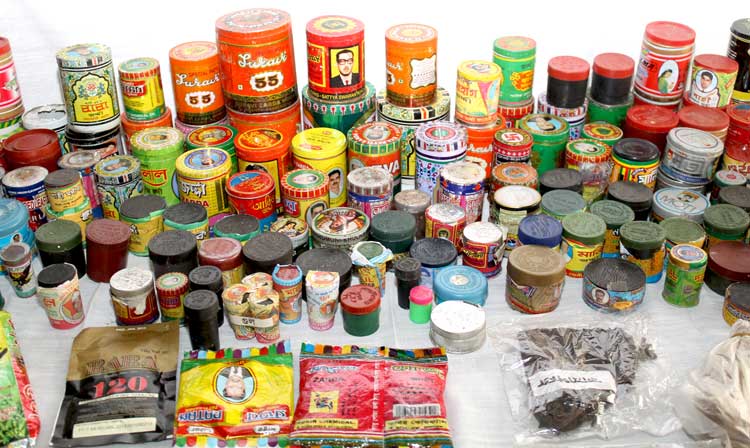TABINAJ Fact Sheet: Smokeless Tobacco - Jarda, Sadapata and Gul

Bangladesh has one of the highest rates of smokeless tobacco use in the world with 28 million users. It is mostly used among the adults (27.2%). Rates among women (27.9%) are slightly higher than among men (26.4%). It is also higher than the smoking rates (23%). The only difference is that among adult tobacco users men as smokers is 44.7%, and as users of smokeless is 26.4%; compared to adult women as tobacco users, women as smokers is only 1.5%, and as smokeless tobacco users it is 27.9%. In general, it is men mostly, who are using tobacco products in both smoke and smokeless forms[1].
Who are the Users?
1. Rural people
Smokeless tobacco use is higher among adults in rural areas than in urban areas (28.8%) versus (22.5%).
2. Less educated people
Smokeless tobacco use is more than four times as high among adults with no formal education as among adults that have completed secondary school or above (42.3% versus 10.2%).
3. Poorer people
Adults with the lowest wealth index (a proxy for socioeconomic status) have the highest rates of use (36.1%), and adults with the highest wealth index have the lowest (17.3%).
In general, the general observation is that smokeless tobacco product use is socially accepted but not as 'fashionable' as cigarettes among the urban, educated and the middle class men and women. So, these are used mostly by rural, less educated and the poorer people. Poor and lower income people both in rural and urban areas have significant difference in wealth index of 36.1% among lowest wealth index vs. 17.3% in the highest wealth index.
Known health impacts
Not much research has been conducted on the health impacts of smokeless tobacco. Smokeless tobacco causes serious health harms, including cancer, adverse reproductive outcomes, toxicity (including stillbirth, preterm birth and low birth weight), precancerous oral lesions, cardiovascular diseases and addiction[2]. The incidence of such health impacts are found but no research is done to document the extent.
Form of smokeless tobacco products
The most common form of smokeless tobacco used among adults is betel quid with tobacco (24.3%), followed by gul (5.3%), sada pata (1.8%), and khoinee (1.5%).
Production of smokeless tobacco: Jarda and Gul
A TABINAJ study conducted in 38 districts found 123 factories producing 225 brands of jarda and 23 factories producing 18 brands of gul. These are mainly cottage industry-based having names such as chemical works and perfumery using deceiving methods to hide smokeless tobacco production[3].
Control of smokeless tobacco products:
Control of smokeless tobbaco products was not possible under the Smoking and Tobacco Products Usage (Control) Act, 2005, as it did not include smokeless tobacco in the definition of tobacco products.
Due to the advocacy on the issue, Smoking and Tobacco Products Usage (Control) (Amendment) Act, 2013 (Bangla) included four most common types of smokeless tobacco products in the definition.
(c) "Tobacco Products" means any product made from tobacco, tobacco leaves, or its extract which can be sucked or chewed, or inhaled through smoking and shall include bidi, cigarette, cheroot, gul, jarda, khoini, sadapata (chewing tobacco), cigar, hukka mixtures used in pipe;
Pictorial warnings on smokeless tobacco products
Bangladesh government passed the smoking and tobacco product usage (control) act 2005 (amended in 2013) and rules have been formulated to this law in 2015. It has been stated that "Health warnings shall be printed on both sides of the packet, cover, carton or box of tobacco products, covering at least 50% of the total area of each main display area or if the packets do not have two main sides in that case covering at least 50% of the main display area, with colored pictures and accompanying text, according to the act, about the harms caused by the use of tobacco products and these shall be printed in Bengali"
The following warnings shall be printed on the packet, cover, carton or box of tobacco products, i.e. For smokeless tobacco products:-
(a) Consumption of tobacco products causes mouth and throat cancer
(b) Consumption of tobacco products causes harms to the fetus.
In the amended law, there are two warnings mentioned in relation to smokeless tobacco products.
Report